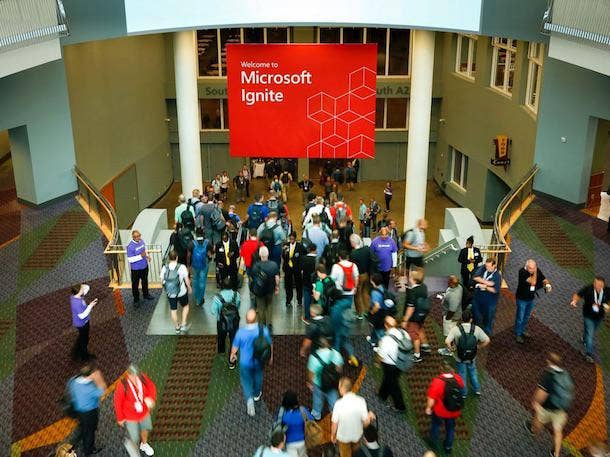Microsoft Expands Virtual Desktops And Virtual WAN: 5 Things To Know

Microsoft has been busy during its Ignite 2018 conference this week. After unveiling product announcements across Office 365, security, Azure and IoT, the company has unveiled a pair of new offerings focused on virtualization technologies.
[Related: Microsoft Ignite 2018: 9 Key Updates To Office 365 And Security]
The first, Windows Virtual Desktop, provides a new virtualized Windows and Office experience on Azure. For the second announcement, Microsoft and VMware said they are now integrating VMware NSX SD-WAN by VeloCloud with Microsoft's Azure Virtual WAN, for simplified high-performance connectivity across branch locations.
What follows are five key things to know about Microsoft's latest moves in virtual desktop and virtual WAN.
Windows Virtual Desktop
Microsoft announced a new offering, Windows Virtual Desktop, which aims to address some of the complexities traditionally associated with desktop virtualization. Windows Virtual Desktop is essentially a new edition of Windows 10—delivering a multi-user Windows 10 experience, Microsoft said—while the service also provides a Windows 7 virtual desktop option. The Windows Virtual Desktop is run on Microsoft's Azure cloud platform.
Ultimately, Windows Virtual Desktop is the "most scalable service to deploy and manage Windows virtual machines, using Azure for compute, storage, rich diagnostics, advanced networking, connection brokering, and gateway," Microsoft said in a blog post. "You no longer need to host, install, configure, and manage these components yourself—so you can deploy and scale in minutes."
Windows Virtual Desktop: Apps
Along with Windows 10 and Windows 7, the Windows Virtual Desktop service also offers virtualized Office 365 ProPlus for multi-user scenarios, Microsoft said. "Microsoft Office is the most virtualized app used, and we are committed to deliver the best possible virtual experience," Microsoft said in the blog post, adding that more investments in the Office 365 virtualized experience for the Windows Virtual Desktop service will be shared "in the months ahead."
Additionally, the Windows Virtual Desktop will offer compatibility with Microsoft Store and existing Windows line-of-business apps "while delivering cost advantages previously only possible with server-based virtualization," Microsoft said.
Windows Virtual Desktop: Partners
The Windows Virtual Desktop service can be provided as an entire desktop experience or for delivering only specific apps, Microsoft said. "We recognize that there is a need for different capabilities to serve our broad set of customers," Microsoft said in its blog post. "To accommodate this need, we have built Windows Virtual Desktop as a platform that can be easily extended and enriched by partners."
The Windows Virtual Desktop service will be available from Microsoft's Cloud Solution Providers, who "will be able to offer Windows Virtual Desktop to their customers and offer additional value around the service," Microsoft said. Vendor partners that are also working with the service include Citrix and CloudJumper, Microsoft said.
Ric Opal, vice president at Oak Brook, Ill.-based SWC Technology, said that Microsoft's Windows Virtual Desktop service is appealing on a number of fronts.
"Given the client's need to get current with their technology and stay current, and to move to the cloud and reduce an on-premises footprint regardless of whether they're in the data center or the desktop, this solution affords the customer both luxuries," Opal said in an interview with CRN.
Cyber threats "are coming so very fast, that if you can't keep your modern workplace infrastructure current, all you're doing is increasing your risk exposure to cyber threats," he said. "The fact that a partner such as us could configure, manage and maintain that environment I think is going to be pretty compelling to many customers, especially the mid-market customers that we serve."
Additionally, compared to other desktop virtualization solutions, "there's some simplicity offered here in the context of a reduced vendor set, that's going to probably provide a client and a partner with a better experience," Opal said.
New VMware NSX-Microsoft Azure Integration
In July, Microsoft announced the Azure Virtual WAN, a networking service that gives businesses optimized branch to branch connectivity and connection to Azure using last mile internet. On Tuesday, VMware and Microsoft announced a new integration between VMware NSX SD-WAN by VeloCloud and Azure Virtual WAN. The integration will enable Azure customers "to gain simple, automated and high-performance connectivity to the branch," VMware said in a news release. "This new solution will extend customers’ current ability to connect workloads running in Azure using VMware NSX SD-WAN and VMware NSX Data Center, and enable customers to deliver pervasive connectivity and intrinsic security from branch locations to Azure."
Deployment Options
VMware and Microsoft said that customers will be offered an array of "flexible" deployment options. Those will include deployments that require only minimal changes to existing networks. "Enterprises will be able to connect to Virtual WAN through globally distributed NSX SD-WAN hosted gateways, by deploying Virtual NSX SD-WAN Edges on Azure, or by connecting directly to Virtual WAN," VMware said in its news release.
Ultimately, "through this collaboration, Microsoft and VMware will offer large-scale branch connectivity in a simple, secure, and unified manner to Microsoft customers," said Yousef Khalidi, corporate vice president for Microsoft Azure, in the news release.